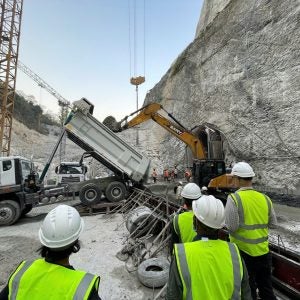Understanding why people do things the way they do can form an invaluable basis for worker and public safety within the hydro industry. As two companies from Australia and Canada demonstrate, there are numerous advantages to applying psychological understanding to safety principles.
An innovative psychology based training programme has been pioneering employee safety in the Australian energy sector. Applying a psychological understanding to young people’s risk perception has been critical to the success of Stanwell Corporation’s recent health and safety initiative.
Stanwell, Queensland’s largest energy provider, launched the You Only Live Once (YOLO) Young Worker Safety Intervention in 2013 after three apprentices were injured at Stanwell power station near Rockhampton, all within a three-month period.
The YOLO programme now runs annually for young workers beginning employment at Stanwell and has achieved a 75% decrease in injuries. Some of 2017’s first year apprentices, trainees and selected mentors from company’s 88MW Kareeya hydro power station gathered recently in Brisbane to attend sessions on the YOLO training calendar.
“Safety is our number one value and is an absolute priority at Stanwell,” Chief Executive Officer Richard Van Breda told the young workers during the interactive training session which enables participants to understand how the brain works in young people, while working to bridge the developmental gap. Van Breda stated that the best safety tool the youngsters have isn’t their personal protective clothing, but actually thinking about safety, being aware of hazards, and being solely focused on what they’re doing. He emphasised that essentially ‘safety means being selfish to ensure you and others on site return home each day to your loved ones’.
AJ Glazebrook is Stanwell’s Health, Safety and Environment Corporate Culture Specialist. She explains that their young workers were not identifying and effectively controlling workplace hazards and, after looking into this from a psychological perspective, it became clear that the workers were all under 25 years of age. As Glazebrook points out, the part of the brain that assesses risk, identifies hazards and looks for a way to effectively control them, is not fully developed in humans under 25.
With this in mind the company designed and started the YOLO programme in 2014 which was based on psychological principles interwoven with evidence-based safety tools for hazard management training. Speakers from the Paraplegic Benefit Fund have also been invited to sessions to give first hand accounts of the consequences of a workplace accident. Glazebrook says this is a real link for young people. They begin to appreciate that a workplace accident could result in them ending up up in a wheel chair or even losing their life.
Understanding risk takers
Tony Bennett is the Director of Dams and Public Safety at Ontario Power Generation (OPG) in Canada and has been looking at safety from another perspective. For the past 15 years he has been working to improve public awareness of the life-threatening dangers surrounding hydropower dams and operations. He believes that in recent years “real inroads” have been made to improving public perception of such hazards.
OPG worked with the Centre for Addiction and Mental Health to improve their understanding of why some people ignore warning signs, barriers and communications around water safety. They worked together on a study about public perception of the dangers of swimming and boating near dams, as well as carrying out a deeper analysis of the risk takers who actively ignore warning signs and continue to trespass.
The study showed that while these individuals may be aware of dangers near dams, they do not think they will be affected. However, they are more likely to respond to warnings of potential charges and fines if caught trespassing at hydro facilities.
As a result of this research OPG said that it modified its water safety messages and said that working with the Centre for Addiction and Mental Health proved to be invaluable in communicating tougher messages.
“What we found is that if you put up an effective sign, 97 % of people will respect it and keep out,” Bennett said. “But if you have an ineffective sign, it doesn’t matter what words are on it, people are going to walk by it. That’s why we have spent so much time researching to make sure our signs worked.”
As Glazebrook from Stanwell reiterates, applying a phycological approach to safety enables you to look at why people do things the way they do. Once you have grasped an understanding of this, it enables you to tailor safety programmes accordingly.






